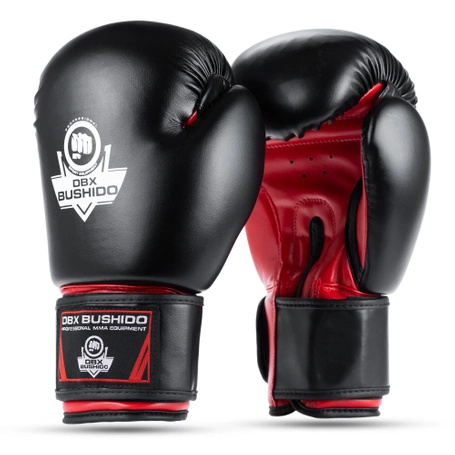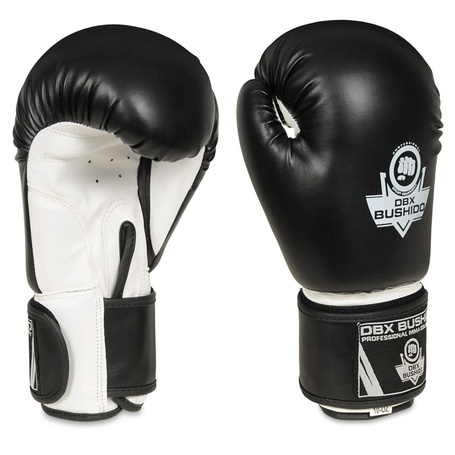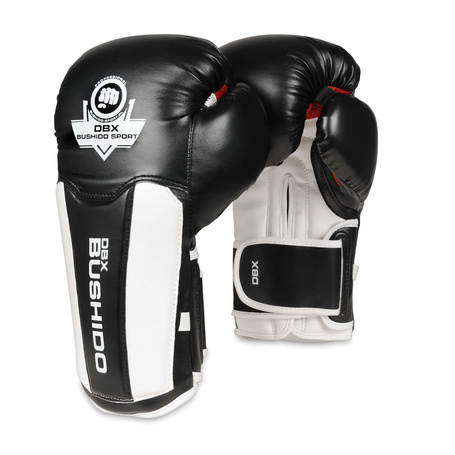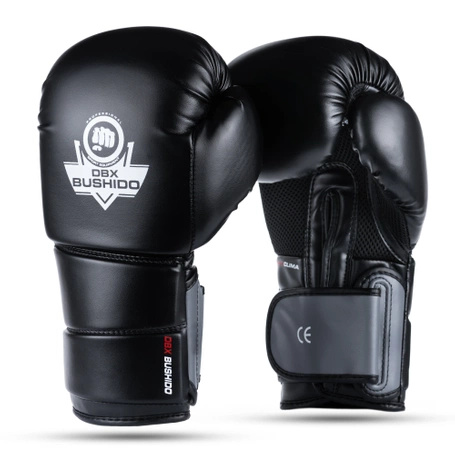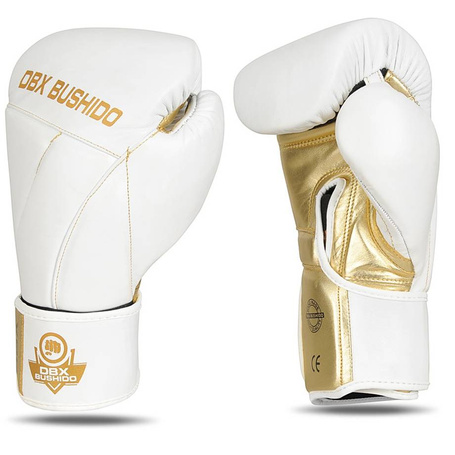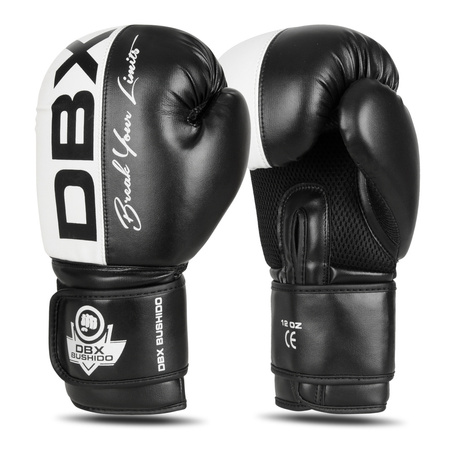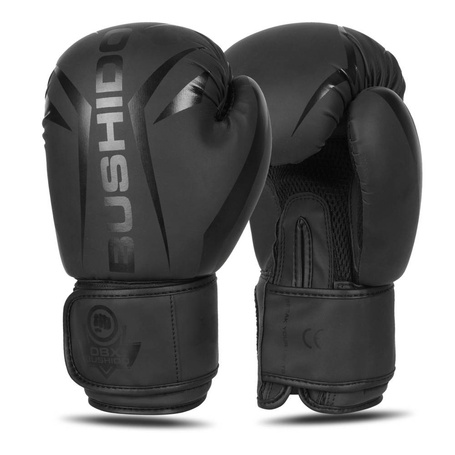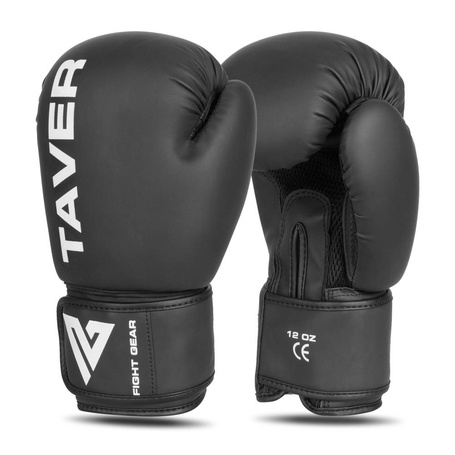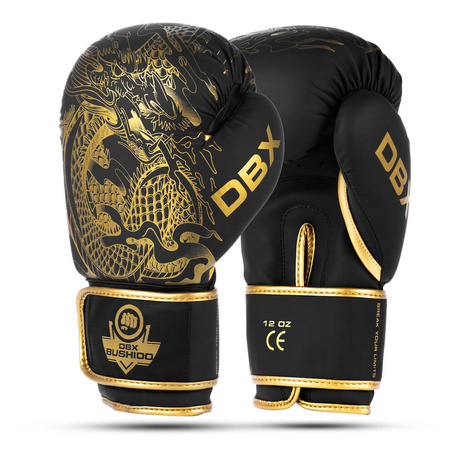Boxing gloves - what size to choose, what to follow?
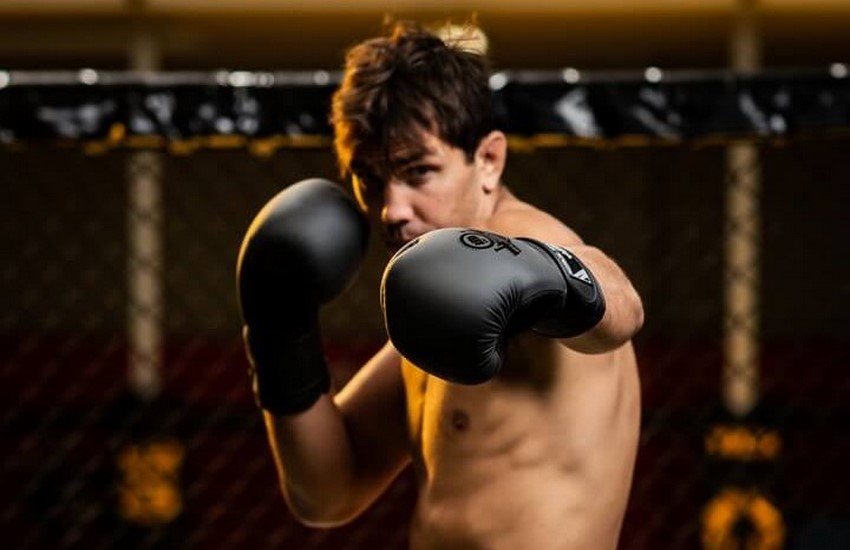
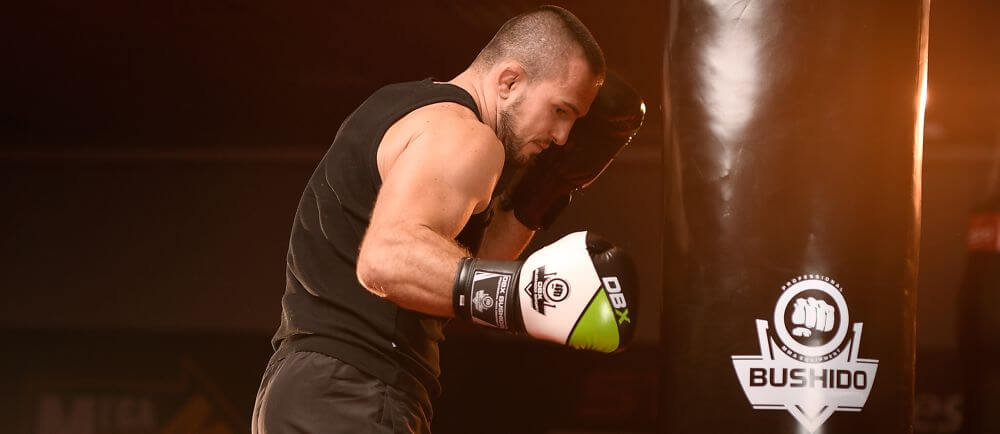
There are many legends about the supposedly simple topic of choosing the right size of boxing gloves, which today we will try to clarify for you. It's worth taking a moment to read, because you'll save yourself and your sparring partners some health, and that's mainly what this is all about. I will also explain how to choose boxing gloves for myself and give some interesting facts about them.
Oz meaning the weight of the boxing gloves and not their size.
The first thing you encounter when choosing a size is the enigmatic at first glance numerical term Oz, or number of ounces, and thus the weight of a particular model. This system has been used for years by almost all manufacturers in the world, where one ounce equals about 28 grams. Noteworthy, the number of ounces does not necessarily and generally does not translate into the size of a particular glove size.
What affects the size of boxing gloves ?
The size of a particular model of boxing gloves is determined primarily by the materials used - especially the filling of the gloves. Most gloves are filled with foam, but depending on its parameters, its volume and weight can vary significantly.
On the market you can also find many models of boxing gloves with layered filling in which each layer is made of a different material and different parameters.
An additional element that can affect the weight of the gloves can be additional inserts in the wrist area or in the blocking zones as is the case, for example, in the following glove models. 
Does glove weight affect glove size ?
This difference, however, ceases to be so noticeable from a weight of 10 oz and above, at higher weights the external volume of the gloves increases, which is related to the use of more and more foam in the impact zone, but the internal size of the gloves is very similar and usually the difference does not exceed 1 cm, which in the case of boxing gloves is not so important and can be reduced by using the appropriate length boxing wraps or inner gloves
Shown below are boxing glove inserts weighing : 10 oz and 14 oz. As you can see the 14 oz glove insert is larger however the A and B dimensions in both inserts are very comparable. So the outer glove volume and weight has increased but the inner size is very similar. 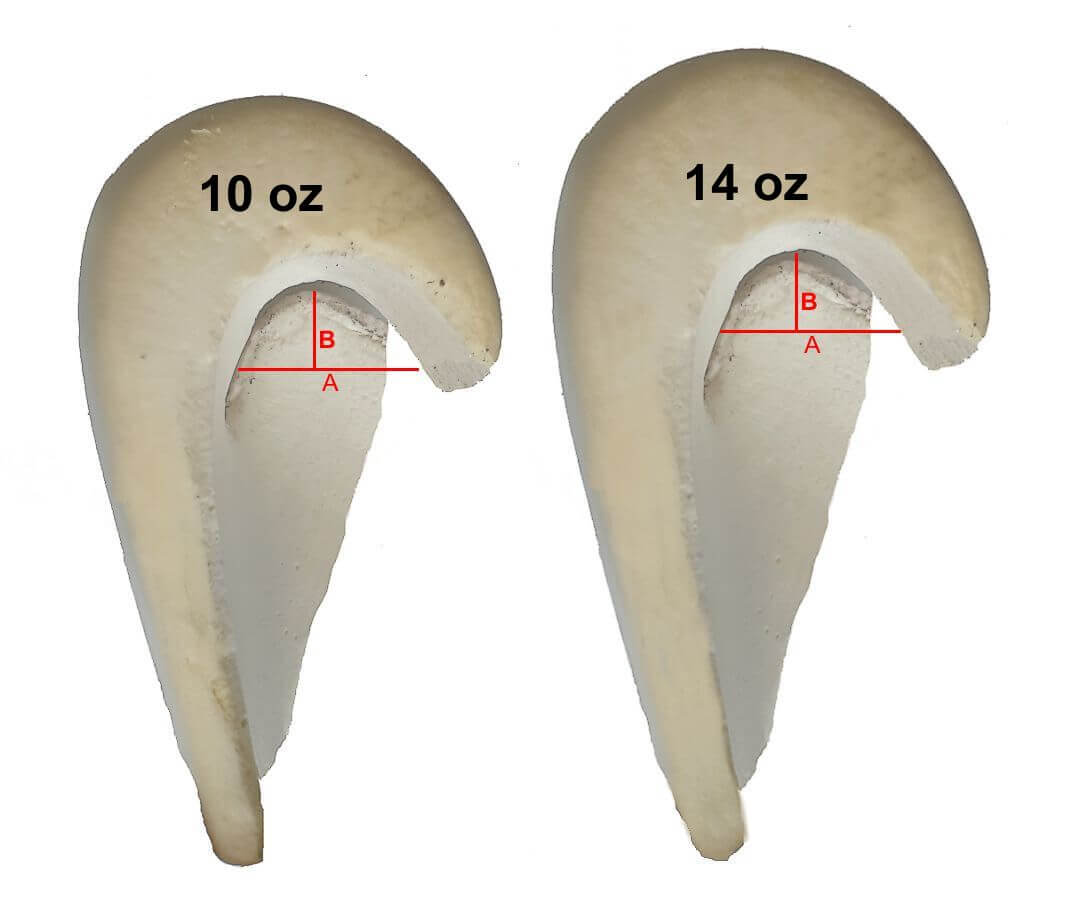
So how to choose the right size/weight gloves?
Since you already know that the weight of gloves quoted by manufacturers does not necessarily go hand in hand with the size of the glove, you're probably wondering how to choose the right one for you in this situation? Fortunately, there is a certain unwritten standard among the vast majority of boxing glove manufacturers as shown in the table below.
| Glove weight | Destination |
| 4 oz - 6 oz | Gloves designed for children up to about 10 years of age |
| 8 oz | Gloves designed for youngsters up to 15 years old and women with small hands. |
| 10 oz - 12 oz | Gloves designed for adults Purpose: technical training, instruments |
| 14 oz and heavier | Gloves designed for adults Purpose: sparring |
Starting with the smallest gloves of 4 oz, they are dedicated under the youngest adepts of combat sports, mostly up to 6 years of age.
Gloves 6 oz a little larger and can be successfully used for children up to about 10 years of age.
The 8 oz gloves are a good choice for women with small hands and for youngsters up to about 15 years of age.
From the weight of 10 oz, the inner size of the gloves is suitable for adults with normal-sized hands. From this weight on, the subsequent weight options do not affect their internal size as much (the maximum difference is usually within 1 cm), so the choice of a specific weight option should be determined by their purpose, which I will write about in the next section.
How to choose boxing gloves according to their purpose ?
As you already know from the weight of 10 oz, the inner size of the gloves does not change that much, however, the outer size changes which is related to the use of more and more filling in the impact zone.
Whether the gloves are larger and thus have a thicker strike zone the safer they are for your sparring partner. An additional advantage of large gloves is that it is easier to hide behind them when blocking blows which will also increase your safety.
In conclusion, the big heavy gloves are great for sparring.
The situation is completely different during technical training, for example, on instruments such as a boxing bag or targets. In this situation, a better solution will be lighter gloves that will make it less difficult to work on technique, dynamics and speed. So let's summarize in the form of a table what size gloves to choose depending on the purpose
| Glove weight | Destination |
| 10 oz | Gloves designed for children up to about 10 years of age |
| 12 oz | Gloves designed for youngsters up to 15 years old and women with small hands. |
| 14 oz and heavier | Gloves designed for adults Purpose: technical training, instruments |
How to choose the weight of gloves depending on your training goal ?
A slightly different system of selecting boxing gloves should be followed when preparing for a competitive start.
Depending on what stage of preparation you are at you should use gloves of a different weight.
If you are at the stage of building strength endurance and conditioning you should use heavier gloves - even if you are only training on instruments.
The closer you get to the competitive start, the more attention is paid to building speed and dynamics and catching freshness, so at this stage you should use lightweight gloves.
In most cases, tournament weights are 10 oz gloves, so in the final stage of preparation you should train with just such gloves. It's important not to limit yourself to training with big gloves all the time, which can lead to bad habits in both blocking and delivering blows.
| Glove weight | Destination |
| 10 oz | Training speed and dynamics, catching freshness |
| 12 oz and heavier | Conditioning and endurance training |
 Myths about. size of boxing gloves.
Myths about. size of boxing gloves.
On the Internet you can find a lot of myths propagated by various people with which I do not fully agree. Let's dissect a few of them.
Myth 1. Choose the weight of the gloves according to your body weight.
This is one of by far the most popular myths with which I disagree. Probably a mental shortcut was used here based on the fact that people who weigh a lot have more strength and thus need thicker (and thus heavier) gloves. Just how do you know that someone who weighs less has weaker strokes than someone weighing more? I know a lot of people who, despite their light weight, have powerful punches as well as a lot of people who, despite their heavy weight, can't hit strongly. ![]() Not true: the weight of the gloves should be selected for the specific application possibly training purpose and not for the weight of the trainer.
Not true: the weight of the gloves should be selected for the specific application possibly training purpose and not for the weight of the trainer.
Myth 2. You should always train with the heaviest gloves possible because it will make you a stronger punch.
Training with heavy gloves will actually fatigue your arms faster so it may be advisable at the stage of developing fitness and endurance. It should be remembered, however, that the power of a blow depends not only on the strength of the muscles but also on many other elements, such as correctness of technique and speed, among others, and these qualities should be developed with the least possible muscle fatigue so as to avoid unnecessary muscle tension and movements. ![]() Not true: the weight of the gloves should be chosen according to your current training goal and this can change depending on what stage of preparation you are at. Training all the time with heavy gloves can perpetuate bad habits.
Not true: the weight of the gloves should be chosen according to your current training goal and this can change depending on what stage of preparation you are at. Training all the time with heavy gloves can perpetuate bad habits.
Myth 3. When training on instruments, it is not worth using gloves which will help harden your fists.
Although from time to time it is worth scoring training on instruments (such as a punching bag) without gloves, for example, to see how we react to the infliction of blows without protectors, it is definitely not a good idea to train like this all the time. During impact, our wrist and joints are exposed to numerous injuries and micro-trauma, which over time can lead to permanent degeneration completely depriving you of the ability to train. ![]() Not true: If you are serious about training for the long term then you need to take care of your hands by using the right gloves.
Not true: If you are serious about training for the long term then you need to take care of your hands by using the right gloves.
 INTERESTING
INTERESTING
In the case of professional gloves used by professionals, fillers with increased density are used so that while maintaining the required weight, such as 10 oz, the size of the gloves is reduced as much as possible.
In some federations, the gloves used are additionally weighted near the cuff which allows the gloves to be even smaller around the impact zone. Ultimately, such gloves despite weighing 10 oz are much smaller and tougher than those commonly used in amateur inches.
These treatments are aimed at making fights more spectacular by increasing the number of knockouts.
Summary
You already know the relationship between weight and size of boxing gloves and which weights to use for a specific application.
If you're going to get into boxing seriously then you'll probably ultimately equip yourself with at least 2 weight options i.e. 10 oz for instrument training and some heavier 14 oz or 16 oz for sparring.
However, if you are just starting out in combat sports and at this point can only afford to buy 1 pair of gloves then I suggest the following:
- 10 oz - if you need gloves for training on instruments at home (for example, on a punching bag)
- 12 oz - if you are starting to train in a club and will be using the gloves for both instrument training and partner exercises.
If you are looking for safe gloves that meet EU CE safety standards at a good price then I encourage you to browse our offer: DBX BUSHIDO Boxing Gloves>>.
Author of entry:
Damian Dubiel

